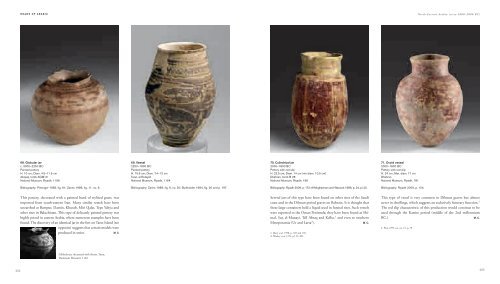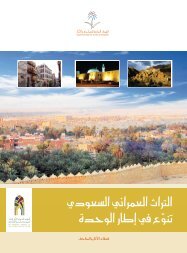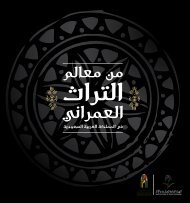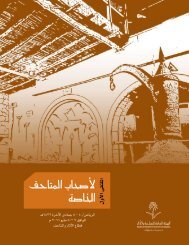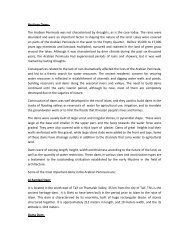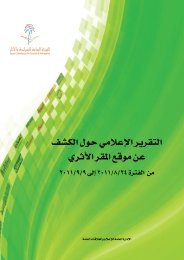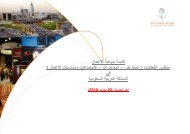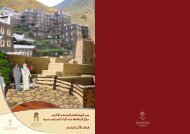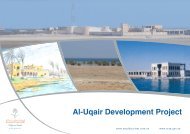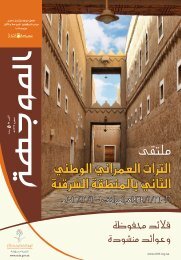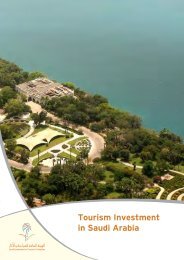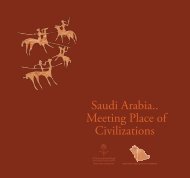Roads of Arabia
Roads of Arabia
Roads of Arabia
You also want an ePaper? Increase the reach of your titles
YUMPU automatically turns print PDFs into web optimized ePapers that Google loves.
12 Arabie US p170-207_CM_BAT.qxd 23/06/10 21:46 Page 202<br />
ROADS OF ARABIA<br />
North-Eastern <strong>Arabia</strong> (circa 5000–2000 BC)<br />
68. Globular jar<br />
c. 3000–2250 BC<br />
Painted pottery<br />
H. 10 cm; Diam. 4.5–11.5 cm<br />
Abqaiq, tomb AGM13<br />
National Museum, Riyadh, 1199<br />
69. Vessel<br />
2200–1800 BC<br />
Painted pottery<br />
H. 15.6 cm; Diam. 7.4–12 cm<br />
Tarut, al-Rufayah<br />
National Museum, Riyadh, 1164<br />
70. Cylindrical jar<br />
2000–1800 BC<br />
Pottery with red slip<br />
H. 22.5 cm; Diam. 14 cm (rim diam. 10.5 cm)<br />
Dhahran, tomb B 28<br />
National Museum, Riyadh, 196<br />
71. Ovoid vessel<br />
2000–1800 BC<br />
Pottery with red slip<br />
H. 24 cm; Max. diam. 17 cm<br />
Dhahran<br />
National Museum, Riyadh, 181<br />
Bibliography: Piesinger 1983, fig. 61; Zarins 1989, fig. 11, no. 6.<br />
Bibliography: Zarins 1989, fig. 6, no. 20; Burkholder 1984, fig. 30 and p. 197.<br />
Bibliography: Riyadh 2009, p. 172; Al-Mughannam and Warwick 1986, p. 24, pl. 20.<br />
Bibliography: Riyadh 2009, p. 104.<br />
This pottery, decorated with a painted band <strong>of</strong> stylized goats, was<br />
imported from south-eastern Iran. Many similar vessels have been<br />
unearthed at Bampur, Damin, Khurab, Miri Qalat, Tepe Yahya and<br />
other sites in Baluchistan. This type <strong>of</strong> delicately painted pottery was<br />
highly prized in eastern <strong>Arabia</strong>, where numerous examples have been<br />
found. The discovery <strong>of</strong> an identical jar in the fort on Tarut Island (see<br />
opposite) suggests that certain models were<br />
produced in series.<br />
M. C<br />
Several jars <strong>of</strong> this type have been found on other sites <strong>of</strong> the Saudi<br />
coast and in the Dilmun period graves on Bahrain. It is thought that<br />
these large containers held a liquid used in funeral rites. Such vessels<br />
were exported to the Oman Peninsula; they have been found at Shimal,<br />
Sur, al-Munayi, Tell Abraq and Kalba, 1 and even to southern<br />
Mesopotamia (Ur and Larsa 2 ). M. C.<br />
1. Mery et al. 1998, p. 169 and 178.<br />
2. Wooley et al. 1974, pl. 52. XII.<br />
This type <strong>of</strong> vessel is very common in Dilmun graves but almost<br />
never in dwellings, which suggests an exclusively funerary function. 1<br />
The red slip characteristic <strong>of</strong> this production would continue to be<br />
used through the Kassite period (middle <strong>of</strong> the 2nd millennium<br />
BC.) M. C.<br />
1. Paris 1999, cat. no. 13, p. 59.<br />
Globular jar decorated with ibexes, Tarut,<br />
Dammam Museum, 1162<br />
202<br />
203


